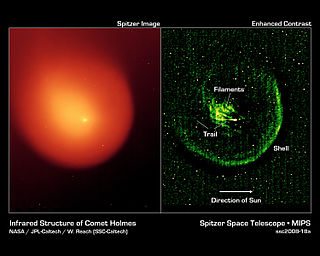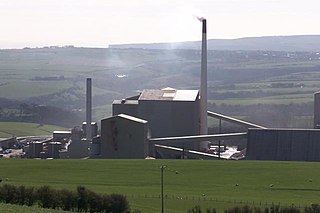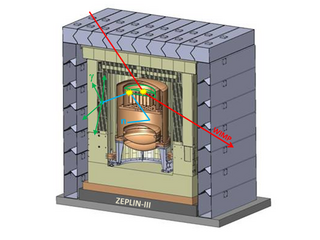Weakly interacting massive particles (WIMPs) are hypothetical particles that are one of the proposed candidates for dark matter.

The coma is the nebulous envelope around the nucleus of a comet, formed when the comet passes close to the Sun on its highly elliptical orbit; as the comet warms, parts of it sublimate. This gives a comet a "fuzzy" appearance when viewed in telescopes and distinguishes it from stars. The word coma comes from the Greek "kome" (κόμη), which means "hair" and is the origin of the word comet itself.
A wire chamber or multi-wire proportional chamber is a type of proportional counter that detects charged particles and photons and can give positional information on their trajectory, by tracking the trails of gaseous ionization.
The Cryogenic Dark Matter Search (CDMS) is a series of experiments designed to directly detect particle dark matter in the form of Weakly Interacting Massive Particles. Using an array of semiconductor detectors at millikelvin temperatures, CDMS has at times set the most sensitive limits on the interactions of WIMP dark matter with terrestrial materials. The first experiment, CDMS I, was run in a tunnel under the Stanford University campus. It was followed by CDMS II experiment in the Soudan Mine. The most recent experiment, SuperCDMS, was located deep underground in the Soudan Mine in northern Minnesota and collected data from 2011 through 2015. The series of experiments continues with SuperCDMS SNOLAB, an experiment located at the SNOLAB facility near Sudbury, Ontario in Canada that started construction in 2018 and is expected to start data taking in early 2020s.

Gaseous ionization detectors are radiation detection instruments used in particle physics to detect the presence of ionizing particles, and in radiation protection applications to measure ionizing radiation.
Elastic recoil detection analysis (ERDA), also referred to as forward recoil scattering, is an ion beam analysis technique in materials science to obtain elemental concentration depth profiles in thin films. This technique is known by several different names. These names are listed below. In the technique of ERDA, an energetic ion beam is directed at a sample to be characterized and there is an elastic nuclear interaction between the ions of beam and the atoms of the target sample. Such interactions are commonly of Coulomb nature. Depending on the kinetics of the ions, cross section area, and the loss of energy of the ions in the matter, ERDA helps determine the quantification of the elemental analysis. It also provides information about the depth profile of the sample.
The XENON dark matter research project, operated at the Italian Gran Sasso National Laboratory, is a deep underground research facility featuring increasingly ambitious experiments aiming to detect dark matter particles. The experiments aim to detect particles in the form of weakly interacting massive particles (WIMPs) by looking for rare interactions via nuclear recoils in a liquid xenon target chamber. The current detector consists of a dual phase time projection chamber (TPC).

The UK Dark Matter Collaboration (UKDMC) (1987–2007) was an experiment to search for Weakly interacting massive particles (WIMPs). The consortium consisted of astrophysicists and particle physicists from the United Kingdom, who conducted experiments with the ultimate goal of detecting rare scattering events which would occur if galactic dark matter consists largely of a new heavy neutral particle. Detectors were set up 1,100 m (3,600 ft) underground in a halite seam at the Boulby Mine in North Yorkshire.
The ArDM Experiment is a particle physics experiment based on a liquid argon detector, aiming at measuring signals from WIMPs, which probably constitute the Dark Matter in the universe. Elastic scattering of WIMPs from argon nuclei is measurable by observing free electrons from ionization and photons from scintillation, which are produced by the recoiling nucleus interacting with neighbouring atoms. The ionization and scintillation signals can be measured with dedicated readout techniques, which constitute a fundamental part of the detector.
PICO is an experiment searching for direct evidence of dark matter using a bubble chamber of chlorofluorocarbon (Freon) as the active mass. It is located at SNOLAB in Canada.

Boulby Mine is a 200-hectare (490-acre) site located just south-east of the village of Boulby, on the north-east coast of the North York Moors in Loftus, North Yorkshire England. It is run by Cleveland Potash Limited, which is now a subsidiary of Israel Chemicals Ltd. (ICL).

DEAP is a direct dark matter search experiment which uses liquid argon as a target material. DEAP utilizes background discrimination based on the characteristic scintillation pulse-shape of argon. A first-generation detector (DEAP-1) with a 7 kg target mass was operated at Queen's University to test the performance of pulse-shape discrimination at low recoil energies in liquid argon. DEAP-1 was then moved to SNOLAB, 2 km below Earth's surface, in October 2007 and collected data into 2011.

Low-energy ion scattering spectroscopy (LEIS), sometimes referred to simply as ion scattering spectroscopy (ISS), is a surface-sensitive analytical technique used to characterize the chemical and structural makeup of materials. LEIS involves directing a stream of charged particles known as ions at a surface and making observations of the positions, velocities, and energies of the ions that have interacted with the surface. Data that is thus collected can be used to deduce information about the material such as the relative positions of atoms in a surface lattice and the elemental identity of those atoms. LEIS is closely related to both medium-energy ion scattering (MEIS) and high-energy ion scattering, differing primarily in the energy range of the ion beam used to probe the surface. While much of the information collected using LEIS can be obtained using other surface science techniques, LEIS is unique in its sensitivity to both structure and composition of surfaces. Additionally, LEIS is one of a very few surface-sensitive techniques capable of directly observing hydrogen atoms, an aspect that may make it an increasingly more important technique as the hydrogen economy is being explored.
Rutherford backscattering spectrometry (RBS) is an analytical technique used in materials science. Sometimes referred to as high-energy ion scattering (HEIS) spectrometry, RBS is used to determine the structure and composition of materials by measuring the backscattering of a beam of high energy ions impinging on a sample.

The Large Underground Xenon experiment (LUX) aimed to directly detect weakly interacting massive particle (WIMP) dark matter interactions with ordinary matter on Earth. Despite the wealth of (gravitational) evidence supporting the existence of non-baryonic dark matter in the Universe, dark matter particles in our galaxy have never been directly detected in an experiment. LUX utilized a 370 kg liquid xenon detection mass in a time-projection chamber (TPC) to identify individual particle interactions, searching for faint dark matter interactions with unprecedented sensitivity.

The European Underground Rare Event Calorimeter Array (EURECA) is a planned dark matter search experiment using cryogenic detectors and an absorber mass of up to 1 tonne. The project will be built in the Modane Underground Laboratory and will bring together researchers working on the CRESST and EDELWEISS experiments.

EDELWEISS is a dark matter search experiment located at the Modane Underground Laboratory in France. The experiment uses cryogenic detectors, measuring both the phonon and ionization signals produced by particle interactions in germanium crystals. This technique allows nuclear recoils events to be distinguished from electron recoil events.
The Dark Matter Time Projection Chamber (DMTPC) is an experiment for direct detection of weakly interacting massive particles (WIMPs), one of the most favored candidates for dark matter. The experiment uses a low-pressure time projection chamber in order to extract the original direction of potential dark matter events. The collaboration includes physicists from the Massachusetts Institute of Technology (MIT), Boston University (BU), Brandeis University, and Royal Holloway University of London. Several prototype detectors have been built and tested in laboratories at MIT and BU. The collaboration took its first data in an underground laboratory at the Waste Isolation Pilot Plant (WIPP) site near Carlsbad, New Mexico in Fall, 2010.

The ZEPLIN-III dark matter experiment attempted to detect galactic WIMPs using a 12 kg liquid xenon target. It operated from 2006 to 2011 at the Boulby Underground Laboratory in Loftus, North Yorkshire. This was the last in a series of xenon-based experiments in the ZEPLIN programme pursued originally by the UK Dark Matter Collaboration (UKDMC). The ZEPLIN-III project was led by Imperial College London and also included the Rutherford Appleton Laboratory and the University of Edinburgh in the UK, as well as LIP-Coimbra in Portugal and ITEP-Moscow in Russia. It ruled out cross-sections for elastic scattering of WIMPs off nucleons above 3.9 × 10−8 pb from the two science runs conducted at Boulby.

The LUX-ZEPLIN (LZ) Experiment is a next-generation dark matter direct detection experiment hoping to observe weakly interacting massive particles (WIMP) scatters on nuclei. It was formed in 2012 by combining the LUX and ZEPLIN groups. It is currently a collaboration of 30 institutes in the US, UK, Portugal and Russia. The experiment is located at the Sanford Underground Research Facility (SURF) in South Dakota, and is managed by DOE's Lawrence Berkeley National Lab.













